
Part 1: The Future of the Clean Power Plan: No Easy Way Out
The Kleinman Center’s Energy Policy Now podcast recently interviewed Cary Coglianese, a Penn professor of Law and Political Science, and the Director of the Penn Program on Regulation, on President Trump’s push for deregulation of environmental protections. During the episode, Coglianese shared his interpretation of the Trump administration’s deregulatory efforts during its first three months, with a focus on President Trump’s executive order directing the EPA to revisit the Clean Power Plan (CPP). The order stands out as a particularly significant and legally complex deregulation effort.
Following Executive Order 13783, the future of the CPP remains largely uncertain. There is, however, little uncertainty that the outcome of this process will influence the role that the United States plays in global carbon mitigation efforts. Because of the significance and complexity of the CPP, the decisions that could be made by the courts, the EPA, and citizen action groups in relation to it are worth further consideration.
The Clean Power Plan, which was issued in its final form under the Obama administration on August 3rd, 2015, sets targets for carbon emission reductions from existing power plants based on state-specific “best systems of emissions reductions” or BSER’s. Following issuance, the Clean Power Plan was heavily contested by state and industry representatives, and has been tied up by litigation for over a year and a half. In February of 2016, the Supreme Court issued a nationwide stay of the rule, meaning that until an opinion from the DC circuit court of appeals is released, implementation of the CPP is on hold.
What’s the Hold Up?
Litigation over a new EPA rule is by no means unusual, but the Clean Power Plan has faced especially strong resistance because of two controversial tactics used by the Obama administration in finalizing the rule.
The first point of contention is over the use of Provision 111(d) of the 1970 Clean Air Act (CAA) amendments. This provision is intended to allow the EPA to regulate existing stationary sources of air pollutants that are not already regulated as “criteria air pollutants” nor as “hazardous air pollutants” under other sections of the act. One condition for EPA using this provision is that the air pollutant is not listed under section 112(b), nor is the pollutant emitted from a source category regulated under section 112.
In 1990 the House and Senate passed slightly different wordings of this provision during the enactment of the CAA amendments and, as a result, created unintended ambiguity in its interpretation. The Obama administration used the Senate’s wording of the provision to justify regulation of carbon emissions from existing power plants. Opponents of the rule say that the House’s wording clearly invalidates this use of the provision because power plants are already regulated under section 112, and thus cannot be subject to CO2 regulations.
The second point of contention is the EPA’s method for setting emissions targets for states by estimating a reasonable growth in low and no carbon energy generation capacity. In other words, the EPA set state targets that are more stringent than they would have otherwise been had the EPA only considered mitigation efforts that could occur within existing power plants or “within the fenceline,” as is more typically the case with EPA regulations. Opponents of this rule say that this unfairly burdens power plants with regulations that are not entirely within an individual power plant’s domain. However, the EPA is not regulating individual plants. Instead, the EPA expects states to determine how reductions within the state are achieved.
Will the Court Delay?
Also included in President Trump’s executive order was authorization for Attorney General Jeff Sessions to request that the DC Circuit Court of Appeals put the CPP case on hold until the EPA prepares a revised rule—a process that could take more than a year.
The DC court does not have to agree to Sessions’ request and could rule on the CPP any day now. In fact, a similar request from the White House to the Supreme Court to postpone a ruling on the “Waters of the United States” (WOTUS) rule was declined on April 3, meaning that the court will move forward with a ruling. The WOTUS rule is another environmental protection finalized by the EPA under the Obama Administration. It too has met strong resistance from industry representatives and states. In part two of this post, we will continue the discussion by analyzing what may happen to the Clean Power Plan if the DC Circuit Court agrees to delay an opinion or if they refuse to delay and either uphold the rule or block it.
Oscar Serpell
Deputy DirectorOscar Serpell oversees all student programming, alumni engagement, faculty and student grants, and visiting scholars. He is also a researcher, writer, and policy analyst working on research initiatives with students and Center partners.

